These are trying times right now.
The spread of COVID-19 is causing a great deal of uncertainty.
Many businesses across the country are forced to shut down to adhere to stay-at-home orders. Only those that are deemed essential can remain open.
Advertising agencies are following suit. 81% of large advertisers are postponing their ad campaigns and slashing marketing budgets.
It’s obvious we can’t ignore what’s going on right now.
So what should you do when a wrench gets thrown into your marketing plans? Do you stop them altogether or cut back on your spending?
It’s difficult to invest in long-term ROI when the short-term is unclear. Your prospects may not be in a position to buy, but they’re still out there.
Stopping marketing at a time like this is a death sentence. The answer then is to shift your budget and priority to short-term ROI.
Refocus your content strategy by getting more out of the assets you already have. You’ll be able to reach prospects across different stages of the sales cycle at a much lower cost.
Let’s look at how your business can benefit by repurposing content.
4 Benefits of Repurposing Your Content
Content is the foundation of inbound marketing—a strategy to draw customers in by producing valuable and engaging content.
This methodology allows you to reach and attract new customers instead of bombarding them with ads. It’s incredibly effective too.
Small businesses with blogs generate 126% more leads than businesses without a blog.
But consistently creating quality content is challenging. Instead, you can repurpose your content and squeeze more value out of your existing assets.
Here are just some benefits of this approach:
1. Reach a New Audience
Consumers use different channels to consume content.
Some prefer watching videos, while others may prefer listening to podcasts. Repurposing your content into new formats allows you to reach a new audience. Another idea is to develop your content strategy focusing on different topics for your audience.
For example, Somnifix, has published tons of articles focusing on nose breathing depending on your activity.
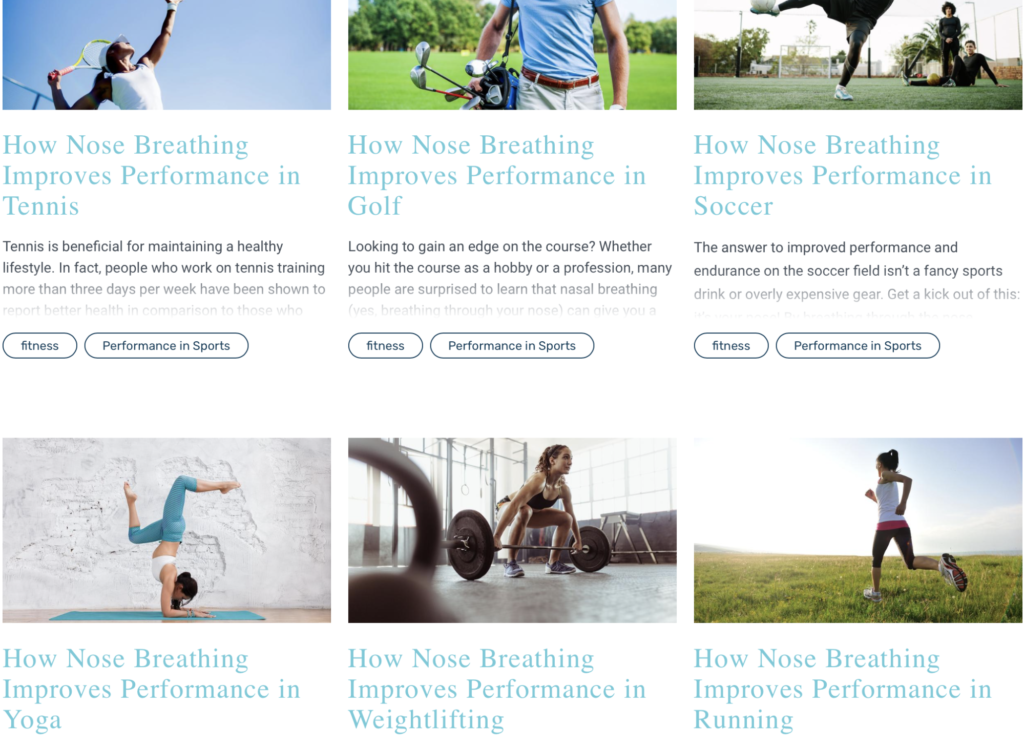
This way, the content is almost the same, but you can publish a series of articles for all types of readers.
2. Spend Less Time on Content Creation
Content creation takes a long time.
Buffer produces in-depth content that ranges from 1,500 to 3,000 words for its marketing blog. Each post takes between 8 to 10 hours to research and write.
By repurposing your content, you can drastically reduce the time it takes to create new content.
3. Boost Your SEO Rankings
More pages represent additional opportunities to rank for targeted keywords. Repurposing your content can also boost your search engine rankings.
Any content you publish to other channels can link back to your site. One approach you can take is to follow the Hub and Spoke method where you write additional follow-ups and post to other sites with a link back to an in-depth article.
4. Reinforce Your Message
Sometimes you need to repeat a message for it to be heard. Repurposing your content helps you reinforce your message as you reach the same prospects across different channels.
Seth Godin says it best, “Delivering your message in different ways, over time, not only increases retention and impact, but it gives you the chance to describe what you’re doing from several angles.”
Now let’s look at how you can refocus your content strategy by using existing assets to engage with your prospects.
Repurpose Content Into 4 Different Formats
Content marketing works.
But you need to consistently create quality content for it to be effective. Otherwise, you risk losing a competitive advantage to companies that prioritize content marketing.
One of the best ways to get more out of your existing assets is to repurpose them into different formats. A hidden benefit with this approach is it allows you to avoid potential duplicate content issues.
Here are some ideas to get your creative juices flowing:
1. Put Together an Ebook
The thought of writing an ebook can be intimidating. These are massive publications that can take weeks to create.
The good news is most of the research is already done. You can compile some of your best content and put them together into an ebook.
You can even turn an ebook into a lead generation magnet—an incentive you offer to visitors in exchange for their email address.
Here’s an example of an ebook on data center infrastructure:

Visitors can download this ebook by simply entering their email address.
But don’t just directly copy and paste your blog posts. Organize your content into chapters and supplement it with engaging visuals.
Use tools like Canva to design an ebook and make it presentable.
2. Create an Infographic
Statistics are rather boring on their own. But you can present data about your industry by turning them into an infographic.
Due to their highly visual and engaging manner, infographics have the potential to go viral. This infographic on the habits of successful people was shared over 25,000 times:
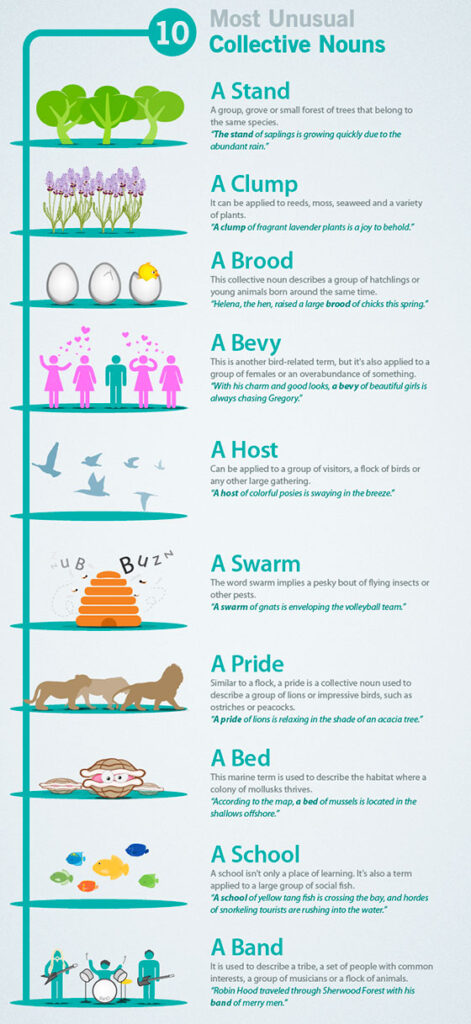
(Source)
Blog posts with infographics also generate 178% more inbound links and 72% more views over standard articles, both of which can improve your bottom line.
Don’t have any design experience? Either hire a professional designer or use a tool like Piktochart to create an infographic based on your data.
3. Create a Video
65% of the population are visual learners. Chances are a large percentage of your audience engages better with material when visual formats are used.
Video is an excellent way to reach prospects who prefer to consume video over text. Repurpose content from your blog, such as tutorials or walkthroughs, into a video.
Post any videos you create onto networks like YouTube, which boasts over 2 billion monthly users. You can even rank in the search results by optimizing your videos.
Here are some videos that PandaDoc displays for the search query “PandaDoc integrations”:

4. Create a Podcast
32% of Americans regularly listen to podcasts. Creating a podcast allows you to tap into a growing platform and open a new way of connecting with your audience.
Use your blog posts as inspiration for your content. You don’t need any fancy gear to get started as you can use your smartphone and a pair of headphones.
Once you’ve finished recording, make the required editings using reliable music software such as GarageBand for PC, publish your new podcasts on platforms like iTunes and Google Play to reach a wider audience.
Update and Refresh Existing Content
As you refocus your content strategy, don’t neglect your blog archive.
By breathing new life into published content, you can boost their rankings and grow your traffic—without having to create new content from scratch.
Updating existing content works because Google rewards freshness. Think about your recent search queries. You’re not just looking for relevant results. You’re looking for results that are relevant right now.
Here’s how you can get more out of your blog by refreshing existing content:
1. Identify Content to Refresh
Instead of simply starting from your very first post, turn your attention to content that shows potential. A good place to start is pages that rank towards the bottom of the first page for their target keywords.
The reason why is simple: Pages that rank at the top of the search results have higher click-through rates (CTR) as shown here:

By revisiting these pages, you can boost their rankings and increase your CTR as a result. Use a rank checking tool like Ahrefs and Serpple to see where your pages are ranking.
Alternatively, you can also view search ranking data with Google Search Console.
2. Update the Content
Take the content you’ve identified in the previous step and make a plan to update them. Use mind mapping software to keep track of your efforts and plan what you need to do next.
You can’t simply add a few sentences and call it a day though. Instead, take your content and update it to make it as comprehensive as possible.
Type your target keyword into Google. What are other searchers looking for? Use these as headings that you can add to your content.
Here’s an example:
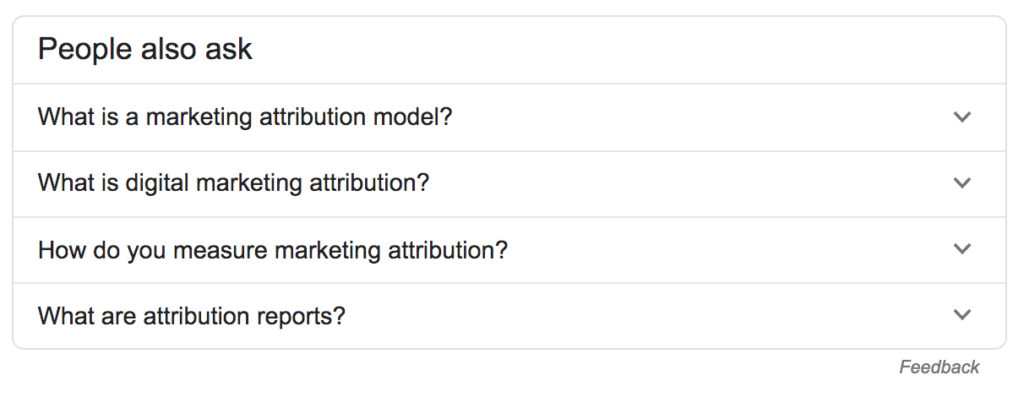
As you go through your content, look through any facts or data you’ve added. Are they still relevant to the topic at hand?
If not, either update them with more recent statistics or cut them out entirely.
Finally, the average content length of results on the first page is 1,890 words.
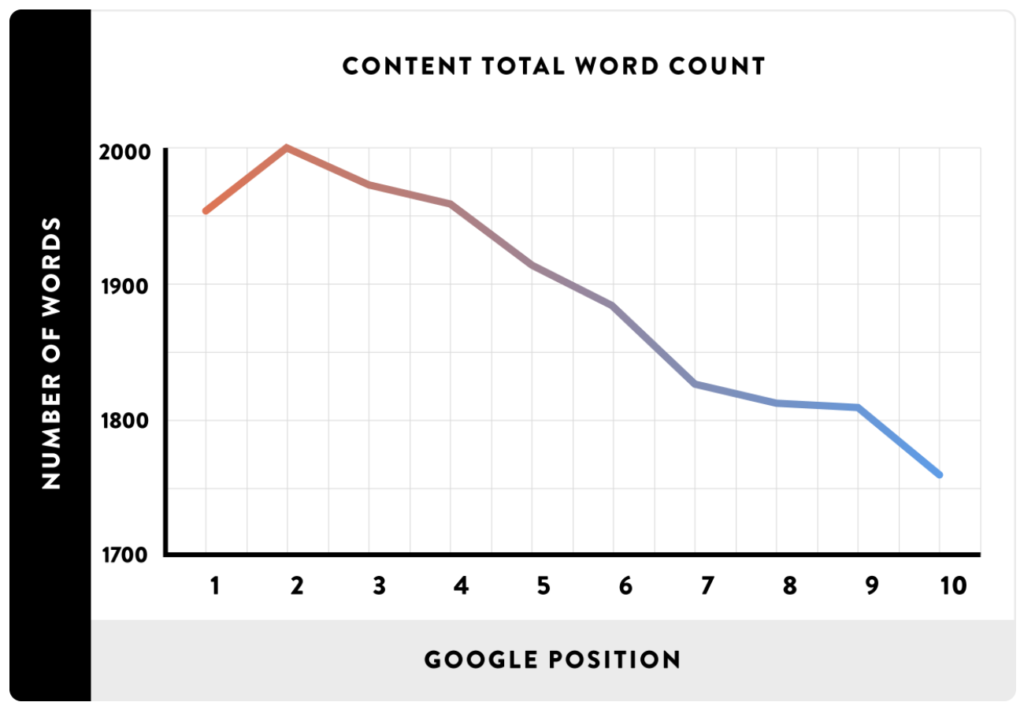
Aim to hit this word count with your content updates. But don’t stuff your content with fluff unless it provides value to your audience.
3. Change Publish Date
Once you’ve finished updating your blog post, publish it as new by changing the publication date in WordPress.
From your post, click on the publish date:

Then hit the Update button.
Updating the publication date gets your content featured as a new post. It also updates the date shown in the search results.
You may also mention on the blog post the last updated page, like in this review of Credit Saint. This confirms to your readers that your content is not outdated.

Finally, promote your content just as you would with any new post. Email it to your email list, add a short blurb to your social media profiles, and reach out to others in your industry to spread the word.
Submit Guest Posts to Relevant Sites
Matt Cutts, former head of search quality at Google, announced the “death” of guest blogging back in 2014.
Here were his exact words:
“Okay, I’m calling it: if you’re using guest blogging as a way to gain links in 2014, you should probably stop. Why? Because over time it’s become a more and more spammy practice, and if you’re doing a lot of guest blogging then you’re hanging out with really bad company.”
This sounds like an obvious call to stop guest blogging. But what he was largely referring to was the practice of using blog networks to build spammy links.
Guest blogging is still very much alive.
It continues to be an effective way to reach a new audience and build high-quality links. Getting your name on major publications sites can also build your authority.
Here’s how you can incorporate guest blogging into your content strategy:
1. Find Sites That Accept Guest Posts
The first step is to find relevant sites that accept guest posts.
The emphasis here is on the word “relevant” as you should read out to sites in your industry. Not only do you have a better chance of getting your content accepted, but you also build a more powerful link.
Use these search operators to find sites you can pitch to:
- “Your topic” + “write for us”
- “Your topic” + “become an author”
- “Your topic” + “guest post”
Here’s an example of sites in the fitness industry that accept guest posts:
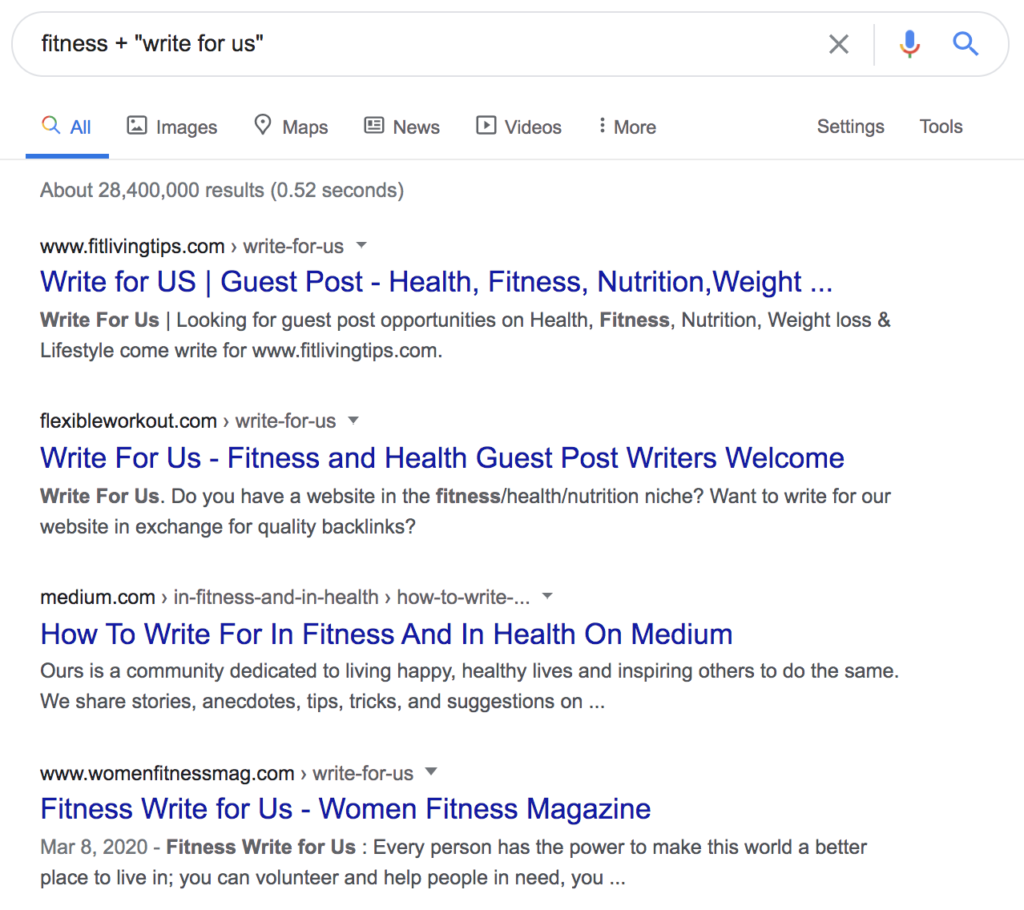
2. Pitch Your Content
Next, reach out to editors of the sites you want to pitch. Here’s an example of an outreach template you can use:
Subject line: Guest pitch for [name of publication]
Hi [webmaster],
I’m [your name] and I publish content on [your industry] over at [yoursite.com].
I’m reaching out because I’m interested in contributing a blog post to your site.
Here are some topics I think your readers would love:
- [Topic #1] – [brief description]
- [Topic #2] – [brief description]
- [Topic #3] – [brief description]
If you’re interested in any of these, please don’t hesitate to get back to me.
Thanks!
[Your name]
Just remember that editors tend to receive tons of emails.
If you don’t hear back, wait at least a week before you follow up again. In the meantime, continue pitching other publications.
3. Write an Engaging Article
Many publications have strict guest posting guidelines. Writing a rehashed article on a broad topic won’t cut it and will likely get rejected.
Don’t take it personally though. Many sites take measures to ensure the quality of their content because they risk alienating their readers if they start accepting anything.
If you want to be featured on an authority site, you’ll need to knock it out of the park with exceptional content. That means your post needs to cover a unique angle and provide a comprehensive overview.
One idea is to take any listicles you’ve published to your blog and flesh them out into individual posts. Another idea is to submit content based on timely events.
Keep Your Content Strategy Moving Forward
The virus has undoubtedly cast a great deal of uncertainty and will continue to impact individuals for the foreseeable future.
Rather than cutting your marketing budget altogether, you can refocus your content strategy instead and get more out of content assets you already have.
Start with the strategies outlined here to get more for less.